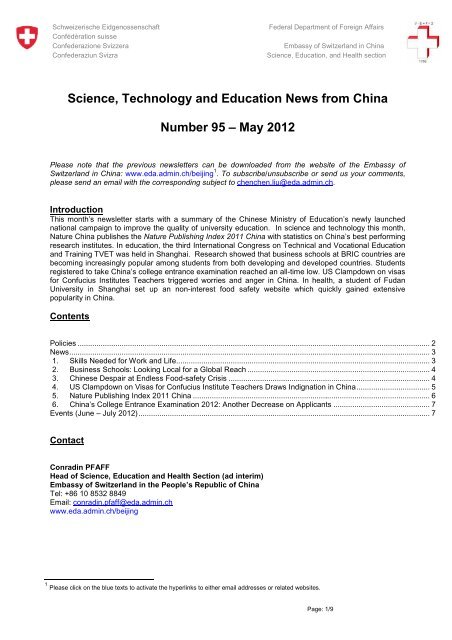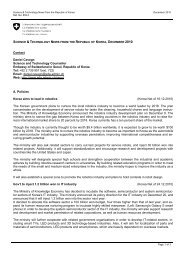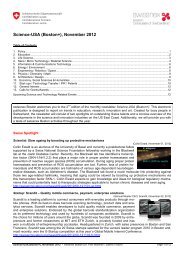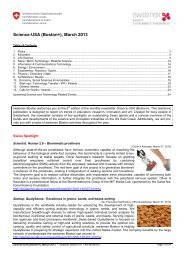May 2012 ion News from China
May 2012 ion News from China
May 2012 ion News from China
Create successful ePaper yourself
Turn your PDF publications into a flip-book with our unique Google optimized e-Paper software.
Schweizerische Eidgenossenschaft<br />
Federal Department of Foreign Affairs<br />
Confédérat<strong>ion</strong> suisse<br />
Confederaz<strong>ion</strong>e Svizzera<br />
Embassy of Switzerland in <strong>China</strong><br />
Confederaziun Svizra<br />
Science, Educat<strong>ion</strong>, and Health sect<strong>ion</strong><br />
Science, Technology and Educat<strong>ion</strong> <strong>News</strong> <strong>from</strong> <strong>China</strong><br />
Number 95 – <strong>May</strong> <strong>2012</strong><br />
Please note that the previous newsletters can be downloaded <strong>from</strong> the website of the Embassy of<br />
Switzerland in <strong>China</strong>: www.eda.admin.ch/beijing 1 . To subscribe/unsubscribe or send us your comments,<br />
please send an email with the corresponding subject to chenchen.liu@eda.admin.ch.<br />
Introduct<strong>ion</strong><br />
This month’s newsletter starts with a summary of the Chinese Ministry of Educat<strong>ion</strong>’s newly launched<br />
nat<strong>ion</strong>al campaign to improve the quality of university educat<strong>ion</strong>. In science and technology this month,<br />
Nature <strong>China</strong> publishes the Nature Publishing Index 2011 <strong>China</strong> with statistics on <strong>China</strong>’s best performing<br />
research institutes. In educat<strong>ion</strong>, the third Internat<strong>ion</strong>al Congress on Technical and Vocat<strong>ion</strong>al Educat<strong>ion</strong><br />
and Training TVET was held in Shanghai. Research showed that business schools at BRIC countries are<br />
becoming increasingly popular among students <strong>from</strong> both developing and developed countries. Students<br />
registered to take <strong>China</strong>’s college entrance examinat<strong>ion</strong> reached an all-time low. US Clampdown on visas<br />
for Confucius Institutes Teachers triggered worries and anger in <strong>China</strong>. In health, a student of Fudan<br />
University in Shanghai set up an non-interest food safety website which quickly gained extensive<br />
popularity in <strong>China</strong>.<br />
Contents<br />
Policies ........................................................................................................................................................................ 2<br />
<strong>News</strong> ............................................................................................................................................................................ 3<br />
1. Skills Needed for Work and Life................................................................................................<br />
......................................................... 3<br />
2. Business Schools: Looking Local for a Global Reach ....................................................................................... 4<br />
3. Chinese Despair at Endless Food-safety Crisis ................................................................<br />
................................................................ 4<br />
4. US Clampdown on Visas for Confucius Institute Teachers Draws Indignat<strong>ion</strong> in <strong>China</strong> ................................... 5<br />
5. Nature Publishing Index 2011 <strong>China</strong> ................................................................................................................. 6<br />
6. <strong>China</strong>’s College Entrance Examinat<strong>ion</strong> <strong>2012</strong>: Another Decrease on Applicants .............................................. 7<br />
Events (June – July <strong>2012</strong>) ........................................................................................................................................... 7<br />
Contact<br />
Conradin PFAFF<br />
Head of Science, Educat<strong>ion</strong> and Health Sect<strong>ion</strong> (ad interim)<br />
Embassy of Switzerland in the People’s Republic of <strong>China</strong><br />
Tel: +86 10 8532 8849<br />
Email: conradin.pfaff@eda.admin.ch<br />
www.eda.admin.ch/beijing<br />
1 Please click on the blue texts to activate the hyperlinks to either email addresses or related websites.<br />
Page: 1/9
Schweizerische Eidgenossenschaft<br />
Confédérat<strong>ion</strong> suisse<br />
Confederaz<strong>ion</strong>e Svizzera<br />
Confederaziun Svizra<br />
Federal Department of Foreign Affairs<br />
Embassy of Switzerland in <strong>China</strong><br />
Science, Educat<strong>ion</strong>, and Health sect<strong>ion</strong><br />
Policies<br />
Chinese Universities: Quality Boost Campaign<br />
The 2’138 universities in <strong>China</strong> are producing mill<strong>ion</strong>s of university graduates every year, making <strong>China</strong><br />
unarguably the country with the biggest university-educated educated talent pool. But the overall scale of resources<br />
doesn’t compensate the lack of high-quality R&D output <strong>from</strong> the faculties, poor academic performance of<br />
students and low employability of fresh graduates.<br />
To address the challenges, the Ministry of Educat<strong>ion</strong> recently launched a “quality boost” campaign,<br />
covering teaching, student competences and employability, research and innovat<strong>ion</strong>. The Ministry<br />
planned to achieve the goal by maintaining the current admiss<strong>ion</strong> capacity, raising the standard,<br />
facilitating cooperat<strong>ion</strong> and implementing reform.<br />
The Ministry of Educat<strong>ion</strong> has decided to maintain the current admiss<strong>ion</strong> capacity of public universities,<br />
implying that the Ministry is ready to put a stop to the rapid expans<strong>ion</strong> of the number of universities and<br />
the quantity of university students. Admiss<strong>ion</strong> capacity growth, however, is allowed for technical colleges,<br />
profess<strong>ion</strong>al masters, private universities and joint institutes.<br />
Nat<strong>ion</strong>al quality standards for both faculty and students will be set up for universities and technical<br />
colleges to streamline future assessments. Special training plans are to be made for students in “priority<br />
majors” such as medical doctors, lawyers, engineers, teachers and agriculture scientists in order to<br />
enhance their competence. Courses in innovat<strong>ion</strong>, novat<strong>ion</strong>, entrepreneurship and profess<strong>ion</strong>alism are to be<br />
offered to improve students’ overall employability. Universities are required to set progressive goals on<br />
the percentage of faculty members and students with overseas study/ training experience.<br />
Internat<strong>ion</strong>al cooperat<strong>ion</strong> is considered as one of the key drivers to boost the quality of educat<strong>ion</strong>. On<br />
collaborative programs, faculty and student exchange, transferrable credits and joint degrees and<br />
facilities are encouraged and supported. The Ministry is also ready to support a few “model joint<br />
institutes” ” and a few Chinese universities’ offshore establishment, , which <strong>China</strong> believes is an<br />
indicat<strong>ion</strong> of concrete internat<strong>ion</strong>al cooperat<strong>ion</strong>.<br />
Attracting overseas talents stays a priority, and the stakes have been en raised. On top of existing incentive<br />
programs such as the “Thousand Talent Program”, overseas talents will be allowed to take up posit<strong>ion</strong>s<br />
as deans and presidents—both posit<strong>ion</strong>s carry certain political implicat<strong>ion</strong>s and hereinbefore open only to<br />
Chinese nat<strong>ion</strong>als.<br />
On research and development, universities are encouraged to pair with peer universities, research<br />
institutes and local governments to form “innovat<strong>ion</strong> consortiums” in order to facilitate “industrial<br />
development”, “reg<strong>ion</strong>al development” and “social development” with maximized resource and personnel<br />
capacity. The consortium plan is termed “Project 2011” ” and will be the priority for the Educat<strong>ion</strong> Ministry<br />
in the near future. Social sciences are also set to play a more important role in university research, with<br />
country studies, sinology, development planning and nat<strong>ion</strong>al policy making being the most prioritizes<br />
areas. Universities are encouraged to act as think tanks at home to provide consulting services to not<br />
only the governmental but also the private sector.<br />
The campaign is a clear indicat<strong>ion</strong> on the current challenges faced by the Chinese higher educat<strong>ion</strong><br />
sector—declining quality of the university curriculum, loosening of academic standards, lack of innovat<strong>ion</strong><br />
capacity among the researchers and detachment <strong>from</strong> the industry. On another note, the new projects<br />
and policies reaffirmed the fact that university management as well as its activities is still highly<br />
centralized in <strong>China</strong>. R&D is highly top-down, priority-driven and project-based. .<br />
Page: 2/9
Schweizerische Eidgenossenschaft<br />
Confédérat<strong>ion</strong> suisse<br />
Confederaz<strong>ion</strong>e Svizzera<br />
Confederaziun Svizra<br />
Federal Department of Foreign Affairs<br />
Embassy of Switzerland in <strong>China</strong><br />
Science, Educat<strong>ion</strong>, and Health sect<strong>ion</strong><br />
<strong>News</strong><br />
1. Skills Needed for Work and Life<br />
(<strong>China</strong> Daily, 10-05-<strong>2012</strong>)<br />
The Third Internat<strong>ion</strong>al Congress on Technical and Vocat<strong>ion</strong>al Educat<strong>ion</strong> and Training (TVET) opens in<br />
Shanghai on <strong>May</strong> 14. Convened by UNESCO in partnership with internat<strong>ion</strong>al development partners, it<br />
will bring together about 800 delegates <strong>from</strong> UNESCO's 195 member states representing a wide range of<br />
stakeholders including ministries of educat<strong>ion</strong>, labor, finance and health; internat<strong>ion</strong>al organizat<strong>ion</strong>s, the<br />
private sector, employee organizat<strong>ion</strong>s, trade un<strong>ion</strong>s, academia, youth and civil society. The participants<br />
reflect the multi-dimens<strong>ion</strong>al nature of the challenge of reforming TVET at a time when skills and<br />
employment have become a leading policy concern worldwide.<br />
Thirteen years after the Second Internat<strong>ion</strong>al Congress in Seoul in 1999, the Shanghai Congress comes<br />
at a time when there is strong demand for upgrading skills, acquiring new ones, and improving<br />
linkages between learning and work in the face of demographic shifts, rapid labor market changes<br />
and youth unemployment in many countries. The uncertain global l economic condit<strong>ion</strong>s have<br />
heightened the need to transform TVET systems to make them more responsive.<br />
The central focus of the Congress is on how to transform and expand TVET to ensure that all young<br />
people and adults can develop the skills needed for work and life. The Congress will provide a unique<br />
platform for the sharing of knowledge, best practices and innovative ideas and charting new direct<strong>ion</strong>s for<br />
transforming TVET systems.<br />
The Chinese TVET system connects educat<strong>ion</strong> at various levels and is linked with general educat<strong>ion</strong>. It<br />
has over 6,000 technical schools and employment training centers and 20,000 private vocat<strong>ion</strong>al training<br />
institut<strong>ion</strong>s. Enrollment in secondary vocat<strong>ion</strong>al educat<strong>ion</strong> is now about 22 mill<strong>ion</strong>, more than half of the<br />
total higher school ol level enrollment; the highest proport<strong>ion</strong> in any country in the world. Even in higher<br />
educat<strong>ion</strong>, almost half the students now are enrolled in vocat<strong>ion</strong>al educat<strong>ion</strong>. The government provides<br />
financial support to 12 mill<strong>ion</strong> secondary vocat<strong>ion</strong>al students <strong>from</strong> rural areas and families with financial<br />
difficulties. The employment rate of graduates of secondary vocat<strong>ion</strong>al educat<strong>ion</strong> remains more than 95<br />
percent and higher vocat<strong>ion</strong>al educat<strong>ion</strong> employment is more than 72 percent.<br />
One of the salient features of <strong>China</strong>'s vocat<strong>ion</strong>al educat<strong>ion</strong> is the strong cooperat<strong>ion</strong> among government,<br />
enterprises, trade associat<strong>ion</strong>s and training institut<strong>ion</strong>s. Nevertheless the next phase of <strong>China</strong>'s social and<br />
economic development will pose challenges for the TVET system which will have to step up to meet the<br />
needs of what will soon be the world's largest economy in terms of GDP. <strong>China</strong> is seeking a major<br />
transformat<strong>ion</strong> <strong>from</strong> being a low-end manufacturing hub to a more sophisticated, service-oriented and<br />
creative economy. While it seeks to improve its competitiveness through innovat<strong>ion</strong> it has to reduce its<br />
carbon emiss<strong>ion</strong>s, minimize ecological damage and improve energy efficiency. The TVET system will<br />
have to shoulder the responsibility of training a more skilled work force capable of adapting to the new<br />
demands of the labor market, globalizat<strong>ion</strong> and technological upgrading through a process of lifelong<br />
learning. This will require openness and flexibility to cater to the needs of youth, women and the aging<br />
populat<strong>ion</strong>.<br />
The migrat<strong>ion</strong> of rural people to cities poses a major challenge in terms of livelihoods of migrants,<br />
reskilling surplus agricultural labor and urban integrat<strong>ion</strong>. Modernizat<strong>ion</strong> of agriculture, development of the<br />
non-farm sector and the balanced development of the rural and urban areas demand a more diversified<br />
and dynamic TVET system.<br />
All these and other related issues will be examined at the Shanghai Congress. This will provide an<br />
excellent opportunity for Chinese policymakers, academics and enterprises to share experiences;<br />
compare systems and fine tune their nat<strong>ion</strong>al strategies to improve the quality of TVET so as to respond<br />
to the expectat<strong>ion</strong>s of their societies, especially youth, and to tackle emerging inequities to achieve the<br />
vis<strong>ion</strong> of a sustainable moderately well-off society.<br />
(http://www.chinadaily.com.cn/opin<strong>ion</strong>/<strong>2012</strong>-05/10/content_15259500.htm)<br />
Page: 3/9
Schweizerische Eidgenossenschaft<br />
Confédérat<strong>ion</strong> suisse<br />
Confederaz<strong>ion</strong>e Svizzera<br />
Confederaziun Svizra<br />
Federal Department of Foreign Affairs<br />
Embassy of Switzerland in <strong>China</strong><br />
Science, Educat<strong>ion</strong>, and Health sect<strong>ion</strong><br />
2. Business Schools: Looking Local for a Global Reach<br />
(New York Times, 17-05-<strong>2012</strong>)<br />
Alix Chen earned a scholarship to HEC Paris, a top business school, and then turned it down. Instead,<br />
she chose the Shanghai branch of the <strong>China</strong> Europe Internat<strong>ion</strong>al Business School, or CEIBS, in her<br />
home country.<br />
“The economy here is booming and changing so fast — I was afraid I would lose so much if I left for so<br />
long,” she said by telephone.<br />
Business schools in developing nat<strong>ion</strong>s are getting more attent<strong>ion</strong> <strong>from</strong> both domestic and foreign<br />
students.<br />
Prospective business school students are starting to look beyond tradit<strong>ion</strong>al destinat<strong>ion</strong>s in the West. And<br />
those who are originally <strong>from</strong> the BRIC developing nat<strong>ion</strong>s — Brazil, Russia, India and <strong>China</strong> — are<br />
increasingly exploring the possibilities at home.<br />
This group already has a name. In a column for University World <strong>News</strong> last month, one higher educat<strong>ion</strong><br />
specialist, Rahul Choudaha, called them “glocal students,” or “people who have global aspirat<strong>ion</strong>s, but<br />
need to stay local.”<br />
The number of Westerners studying at BRIC programs is rising, though the total number is still low.<br />
According to the Graduate Management Admiss<strong>ion</strong> Test, the number of U.S., Canadian and West<br />
European students sending GMAT scores to programs in BRIC nat<strong>ion</strong>s increased <strong>from</strong> 381 in 2007 to<br />
639 in 2011.<br />
In 2009, <strong>China</strong> made the list of top-10 countries to which American GMAT test-takers takers sent scores for the<br />
first time. At the Hong Kong University of Science and Technology, the number of applicants <strong>from</strong> North<br />
America and Europe more than doubled between 2006 and 2010.<br />
The United States remains the top M.B.A. destinat<strong>ion</strong> for students <strong>from</strong> BRIC countries. Still, the demand<br />
for Western degrees is leveling off, while demand for local programs is showing signs of rising. The<br />
number of score reports sent by BRIC citizens to home country programs grew 50 percent between 2007<br />
and 2011.<br />
The allure of better job prospects in the emerging markets, particularly <strong>China</strong>, is frequently cited as a<br />
major factor. India, <strong>China</strong> and Brazil are ranked in the top 10 countries to have the largest expected<br />
increases in M.B.A.-related jobs over the next 12 months, according to the 2011-<strong>2012</strong><strong>2012</strong> QS TopMBA.com<br />
Jobs and Salary Trends Report .<br />
American and European M.B.A. programs are responding to these changes by internat<strong>ion</strong>alizing their<br />
curriculums, expanding their study-abroad opt<strong>ion</strong>s, offering joint degrees with foreign campuses and<br />
recruiting students <strong>from</strong> developing nat<strong>ion</strong>s.<br />
Top programs in <strong>China</strong>, India, Brazil and Russia have been around only since the 1990s and are just now<br />
developing the faculty and facilities needed to compete for top internat<strong>ion</strong>al students.<br />
“High-end applicants will not take a risk for an M.B.A., because they need a brand name,” said Dr.<br />
DeKrey of HKUST. “It’s very hard to reconcile an opt<strong>ion</strong> of a top-10 Western school unless you can get<br />
comparable or close to quality brand in Asia. Because we are now able to make that argument, we are<br />
now on the list of those best applicants.”<br />
(http://www.nytimes.com/<strong>2012</strong>/05/18/world/asia/18iht-sreducbric18.html_r=1&partner=rssnyt&emc=rss<br />
html_r=1&partner=rssnyt&emc=rss)<br />
3. Chinese Despair at Endless Food-safety Crisis<br />
(USA Today, 19-05-<strong>2012</strong>)<br />
Salivating on their sofas, TV viewers across <strong>China</strong> have been enjoying a documentary series on the<br />
nat<strong>ion</strong>'s world-famous cuisine. From the lotus and rib soup of Hubei to the mountain mushrooms of Tibet,<br />
Page: 4/9
Schweizerische Eidgenossenschaft<br />
Confédérat<strong>ion</strong> suisse<br />
Confederaz<strong>ion</strong>e Svizzera<br />
Confederaziun Svizra<br />
Federal Department of Foreign Affairs<br />
Embassy of Switzerland in <strong>China</strong><br />
Science, Educat<strong>ion</strong>, and Health sect<strong>ion</strong><br />
<strong>China</strong> on the Tip of the Tongue is so tantalizing that many fans responded online, "I want to lick the<br />
screen."<br />
But another react<strong>ion</strong> to the top-rated food show by state broadcaster CCTV has been disgust at its failure<br />
to highlight one of the most pressing concerns of <strong>China</strong>'s citizens: the daily danger of fake and<br />
adulterated foodstuffs.<br />
Regular surveys reveal that <strong>China</strong>'s authoritarian government struggles to reassure citizens that it can<br />
deliver the safe food they rank as a top priority.<br />
In the city of Guangzhou, whose Cantonese cuisine is celebrated worldwide, more than 46% of residents<br />
are dissatisfied with food safety, and more than 37% said they had suffered recent food-safety problems,<br />
according to a survey released this month by the Guangzhou Public Opin<strong>ion</strong> Research Center.<br />
"There are two <strong>China</strong>s on the tip of the tongue," says Shanghai student Wu Heng, a fan of the series.<br />
"There's the <strong>China</strong> shown on TV, with its tradit<strong>ion</strong>al food culture and long history. Then there's another<br />
<strong>China</strong> shown on my website, the current environment in which black-hearted enterprises make black-<br />
hearted foodstuffs and have a large market."<br />
Wu, 26, became active in the food-safety cause because of his favorite dish of braised beef and rice.<br />
Startled by a news report on fake beef, he was inspired to create an online food-safety database that<br />
allows visitors to add the latest problems nat<strong>ion</strong>wide, often involving the illegal use of additives.<br />
With his website, "Throw It Out the Window," Wu hopes public awareness and pressure will produce bold<br />
steps to tackle <strong>China</strong>'s food-safety crisis. His site attracted more than 1 mill<strong>ion</strong> views a day earlier this<br />
month, Wu says.<br />
<strong>China</strong> appears a long way <strong>from</strong> Western-style food-safety standards when Chinese still can't trust the oil<br />
they use to cook much of their food. For months, authorities have cracked down on "gutter oil," used<br />
cooking oil dredged <strong>from</strong> the gutters outside restaurants and resold. Today, the term refers to any illegal<br />
oil, such as the stuff made <strong>from</strong> rotting animal parts in Zhejiang province and <strong>from</strong> industrial fats used for<br />
soap in Yunnan.<br />
Even the state-run Xinhua <strong>News</strong> Agency despaired this month over food safety, noting formaldehydesprayed<br />
cabbage -- done to retain freshness -- "sparked public anger and prolonged the seemingly<br />
unending discuss<strong>ion</strong> on what, if anything, is safe to eat."<br />
[…]<br />
(http://www.usatoday.com/NEWS/usaedit<strong>ion</strong>/<strong>2012</strong>-05-29-<strong>China</strong>-food-scares_ST_U.htm)<br />
4. US Clampdown on Visas for Confucius Institute Teachers Draws Indignat<strong>ion</strong> in <strong>China</strong><br />
(Washington Post, 25-05-<strong>2012</strong>)<br />
A U.S. clampdown on visas for instructors at <strong>China</strong>’s flagship cultural program overseas has incensed<br />
Beijing, with state media pouncing on it as an attempt by Washington to frustrate Chinese global<br />
ambit<strong>ion</strong>s.<br />
A U.S. directive said many Chinese instructors had the wrong kind of visa, though it appeared largely<br />
resolved by <strong>May</strong> 21. The U.S. State Department expressed regret over how the matter was handled and<br />
said it was working on a way for teachers to update their status without returning home.<br />
But the commot<strong>ion</strong> it set off has underlined <strong>China</strong>’s sensitivity about the more than 300 Confucius<br />
Institutes it has opened globally in less than a decade as a way of spreading its influence abroad.<br />
They primarily give language instruct<strong>ion</strong>, but also engage in cultural exchanges and are set up at<br />
universities overseas, where they have drawn concerns that they are propaganda machines aimed at<br />
stifling academic criticism of <strong>China</strong>’s Communist Party.<br />
The State Department announced <strong>May</strong> 17 that many teachers at Confucius Institutes on U.S. university<br />
campuses would have to switch their visas, because they were teaching kindergarten through 12th grade<br />
Page: 5/9
Schweizerische Eidgenossenschaft<br />
Confédérat<strong>ion</strong> suisse<br />
Confederaz<strong>ion</strong>e Svizzera<br />
Confederaziun Svizra<br />
Federal Department of Foreign Affairs<br />
Embassy of Switzerland in <strong>China</strong><br />
Science, Educat<strong>ion</strong>, and Health sect<strong>ion</strong><br />
while holding visas for university-level instructors. There were fears hundreds of them would have to<br />
return home, disrupting more than 80 U.S.-based institutes.<br />
Chinese state media reacted swiftly, calling the restrict<strong>ion</strong>s an anti-Chinese witchhunt meant to distract<br />
Americans <strong>from</strong> a bleak economic picture in a presidential elect<strong>ion</strong> year.<br />
“This absurd measure reflects illogical thinking and an immature mentality,” said an editorial by state-run<br />
People’s Daily. “Finding scapegoats, witch hunting and shifting focuses are not the right ways to do<br />
things.”<br />
In Washington, State Department spokeswoman Victoria Nuland said the agency was working on ways<br />
for the teachers to update their visas while remaining in the U.S. She said on <strong>May</strong> 22 that the original<br />
directive issued by the U.S. on <strong>May</strong> 17 had been “sloppy and not complete” and a new directive issued<br />
Friday should clarify matters.<br />
“People-to-people people relat<strong>ion</strong>s between the U.S. and <strong>China</strong> are a very high h priority for us,” Nuland told a<br />
news conference. “We want to get this right. That’s why we are fixing this guidance.”<br />
<strong>China</strong> has set up 81 Confucius Institut<strong>ion</strong>s in collaborat<strong>ion</strong> with U.S. colleges since 2004.<br />
They are similar to cultural centers such as France’s Alliance Francaise and Germany’s Goethe-Institut,<br />
but differ in that they make no claim to be independent <strong>from</strong> their country’s government.<br />
Many U.S. universities who host the institute say there’s been no interference <strong>from</strong> the Chinese<br />
government, and say the programs add diversity and much-needed language resources for local<br />
communities.<br />
“The fear that these teachers would import unacceptable content or pedagogy has proven unfounded,”<br />
wrote Susan Carvalho, associate provost for internat<strong>ion</strong>al programs at the University of Kentucky in a<br />
blog for the Chronicle of Higher Educat<strong>ion</strong>.<br />
(http://www.washingtonpost.com/world/asia_pacific/us-clampdown-on-visas-for-confucius-institutes-<br />
teachers-draws-indignat<strong>ion</strong>-in-china/<strong>2012</strong>/05/25/gJQA6FACpU_story.html)<br />
5. Nature Publishing Index 2011 <strong>China</strong><br />
(Nature, 24-05-<strong>2012</strong>)<br />
The Nature Publishing Index 2011 <strong>China</strong> — a supplement to the 24th <strong>May</strong> <strong>2012</strong> issue of Nature —<br />
provides a detailed assessment of the various research strengths of Chinese institut<strong>ion</strong>s and cities based<br />
on their output of research articles in Nature-branded primary research journals in 2011 (with 2010 and<br />
2009 data included for comparison). The publicat<strong>ion</strong> also addresses <strong>China</strong>’s performance in a reg<strong>ion</strong>al<br />
and global context through the Asia-Pacific rankings and the Global rankings.<br />
According to the Nature Publishing Index 2011 <strong>China</strong>, research articles with authors <strong>from</strong> <strong>China</strong> represent<br />
6.6% (225) of the 3425 papers published in Nature-branded primary research journals in 2011, up <strong>from</strong><br />
5.3% (152 papers) in 2010. By comparison, authors <strong>from</strong> <strong>China</strong> published just 12 articles in Naturebranded<br />
primary research journals in 2000. Notably, of the 225 articles published in 2011, 48 were<br />
published in Nature Communicat<strong>ion</strong>s which launched in April 2010.<br />
The top ten Chinese institut<strong>ion</strong>s by contribut<strong>ion</strong> are: the Chinese Academy of Sciences (CAS), the<br />
University of Science and Technology of <strong>China</strong> (USTC), Peking University, Tsinghua University, Hong<br />
Kong University of Science and Technology (HKUST), Xiamen University, Shanghai Jiao Tong University<br />
(SJTU), the University of Hong Kong (HKU), Nanjing University and BGI Shenzhen.<br />
CAS has a strong lead, publishing 62 articles in Nature-branded primary research journals in 2011, but it<br />
must be born in mind that it is a very large institut<strong>ion</strong> with over 100 institutes and close to 50,000<br />
researchers and so a high count is to be expected. Among the universities, USTC is number one ahead<br />
of Peking University and Tsinghua University, which are generally recognized to be the top two<br />
universities in <strong>China</strong>.<br />
Page: 6/9
Schweizerische Eidgenossenschaft<br />
Confédérat<strong>ion</strong> suisse<br />
Confederaz<strong>ion</strong>e Svizzera<br />
Confederaziun Svizra<br />
Federal Department of Foreign Affairs<br />
Embassy of Switzerland in <strong>China</strong><br />
Science, Educat<strong>ion</strong>, and Health sect<strong>ion</strong><br />
The top ten Chinese cities by contribut<strong>ion</strong> are: Beijing, Shanghai, Hefei, Hong Kong, Nanjing, Wuhan,<br />
Xiamen, Hangzhou, Shenzhen and Xi’an. These ten cities account for approximately 86% of <strong>China</strong>’s<br />
contribut<strong>ion</strong> to Nature-branded primary research journals in 2011, and also house 19 of the top 20<br />
institut<strong>ion</strong>s in the <strong>China</strong> rankings.<br />
The Nature Publishing Index 2011 <strong>China</strong> also presents a new analysis of ISI Web of Knowledge data,<br />
showing that <strong>China</strong> now publishes more than 10% of the world’s most cited scientific research. <strong>China</strong><br />
increased its share of the top 1% of highly cited scientific articles <strong>from</strong> 1.85% (127 out of 6,874 articles) in<br />
2001 to 11.3% (1,158 out of 10,238 articles) in 2011, and now ranks fourth globally. By 2014, <strong>China</strong> could<br />
surpass Germany and the United Kingdom, who currently hold second and third places. The United<br />
States, which leads the world, has seen its share of highly influential research drop <strong>from</strong> 64.3% (4,420 out<br />
of 6,874 articles) in 2001 to 50.7% (5,190 out of 10,238 articles) in 2011.<br />
(http://www.natureasia.com/en/publishing-index/china/2011/)<br />
6. <strong>China</strong>’s College Entrance Examinat<strong>ion</strong> <strong>2012</strong>: Another Decrease on Applicants<br />
(Guangming Daily, 1-06-<strong>2012</strong>)<br />
<strong>China</strong>’s College Entrance Examinat<strong>ion</strong>, also known as “Gaokao”, will take place on June 6 -7 again this<br />
year. The examinat<strong>ion</strong> is the only entry point for Chinese high school students to get into Chinese<br />
universities.<br />
Statistics have shown that 9 mill<strong>ion</strong> high h school students are registered for this year’s college entrance<br />
examinat<strong>ion</strong>. The number has been dropping for 4 consecutive years, down <strong>from</strong> 10.4 mill<strong>ion</strong> in 2008.<br />
Accompanying the decline on university applicants is the increase of admiss<strong>ion</strong> capacity and overall<br />
admiss<strong>ion</strong> rate. Chinese universities enrolled a total of 6 mill<strong>ion</strong> students in 2008, and the enrollment<br />
capacity is expected to reach 7 mill<strong>ion</strong> in <strong>2012</strong>, driving the admiss<strong>ion</strong> rate to 75% of up—a record high.<br />
Theoretically, Chinese students now should have more access than ever to higher educat<strong>ion</strong>, but the<br />
higher educat<strong>ion</strong> institutes in <strong>China</strong> are experiencing difficulties in attracting enough applicants. Secondand<br />
third-tier tier universities as well as vocat<strong>ion</strong>al colleges are the most hit. In the province of Shandong,<br />
where admiss<strong>ion</strong> rate was usually one of the lowest, 967 higher educat<strong>ion</strong> institutes failed to admit<br />
enough students in 2011.<br />
The decrease of university applicants and university enrollment might result <strong>from</strong> a) demographic change,<br />
b) increasing interest in overseas studies and c) declining faith in the quality of local universities.<br />
Events (June – July <strong>2012</strong>)<br />
June <strong>2012</strong><br />
5 th Internat<strong>ion</strong>al Symposium on Polymer<br />
Chemistry<br />
Date: June 2 nd<br />
Place: Changchun<br />
Contact: Changchun Institute of Applied<br />
Chemistry, CAS<br />
7 th Internat<strong>ion</strong>al Symposium on High<br />
Technology Polymer Materials<br />
Date: June 3 rd<br />
Place: Xi’an<br />
Contact: Institute of Chemistry, CAS<br />
10 th Internat<strong>ion</strong>al Symposium on Polymer<br />
Physics<br />
Date: June 4 th<br />
Place: Chengdu<br />
Contact: Institute of Chemistry, CAS<br />
11 th Brain Connectivity Workshop <strong>2012</strong><br />
Date: June 6 th<br />
Place: Chengdu<br />
Contact: Institute of Automat<strong>ion</strong>, CAS<br />
The 2 nd <strong>China</strong> Internat<strong>ion</strong>al Exhibit<strong>ion</strong> on<br />
Coal Processing & Utilizat<strong>ion</strong> and Coal<br />
Chemical<br />
Page: 7/9
Schweizerische Eidgenossenschaft<br />
Confédérat<strong>ion</strong> suisse<br />
Confederaz<strong>ion</strong>e Svizzera<br />
Confederaziun Svizra<br />
Federal Department of Foreign Affairs<br />
Embassy of Switzerland in <strong>China</strong><br />
Science, Educat<strong>ion</strong>, and Health sect<strong>ion</strong><br />
Date: June 6 th<br />
Place: Beijing<br />
Contact: <strong>China</strong> Nat<strong>ion</strong>al Coal Associat<strong>ion</strong><br />
6 th Internat<strong>ion</strong>al Weed Science Congress<br />
Date: June 18 th<br />
Place: Beijing<br />
Contact: <strong>China</strong> Society of Plant Protect<strong>ion</strong>m<br />
CAST<br />
The 33 rd<br />
Internat<strong>ion</strong>al Conference on<br />
Programming Language Design and<br />
Implementat<strong>ion</strong><br />
Date: June 11 th<br />
Place: Beijing<br />
Contact: Institute of Computing, CAS<br />
<strong>2012</strong> 4 th Shanghai Internat<strong>ion</strong>al Wear-<br />
Resistant Materials, Industrial Ceramics<br />
Exhibit<strong>ion</strong> and Mining Equipment<br />
Exhibit<strong>ion</strong><br />
Date: June 13 th<br />
Place: Shanghai<br />
Contact: Shanghai S&T Development and<br />
Exchange Center<br />
The 3 rd<br />
(<strong>2012</strong>) Shanghai Internat<strong>ion</strong>al<br />
Surface Engineering and Ceramics<br />
Industry EXPO<br />
Date: June 13 th<br />
Place: Shanghai<br />
Contact: Shanghai S&T Development and<br />
Exchange Center<br />
World Dairy Expo and Summit<br />
Date: June 16 th<br />
Place: Zhengzhou<br />
Contact: <strong>China</strong> Great Wall Internat<strong>ion</strong>al<br />
Exhibit<strong>ion</strong> Co. Ltd.<br />
The 12 th Internat<strong>ion</strong>al PGE Symposium<br />
Date: June 18 th<br />
Place: Guiyang<br />
Contact: Institute of Earth Chemistry, CAS<br />
8 th <strong>China</strong> Internat<strong>ion</strong>al Pressure-casting<br />
Congress and Exhibit<strong>ion</strong><br />
Date: June 19 th<br />
Place: Shanghai<br />
Contact: Shanghai S&T Development and<br />
Exchange Center<br />
4th Internat<strong>ion</strong>al River Land-scape<br />
Summit<br />
Date: June 23 rd<br />
Place: Wuhan<br />
Contact: Wuhan Botanic Garden, CAS<br />
July <strong>2012</strong><br />
The 31 st<br />
IUBS General Assebly and<br />
Conferences on Biological Sciences and<br />
Bioindustry<br />
Date: July 5 th<br />
Place: Beijing<br />
Contact: Institute of Zoology, CAS<br />
The 4 th Internat<strong>ion</strong>al Exhibit<strong>ion</strong> and<br />
Symposium on Exhibits & Technical<br />
Facilities of Science Centers<br />
Date: July 5 th<br />
Place: Beijing<br />
Contact: New Technology Development<br />
Center, Chinese Associat<strong>ion</strong> of Science and<br />
Technology<br />
<strong>China</strong> Shale Gas Forum <strong>2012</strong><br />
Date: July 5 th to 6 th<br />
Place: Shanghai<br />
Contact: http://chinashalegasforum.com<br />
The 9 th<br />
World Conference on Intelligent<br />
Control and Automat<strong>ion</strong><br />
Date: July 6 th<br />
Place: Beijing<br />
Contact: Academy of Mathematics and<br />
System Sciences, CAS<br />
<strong>2012</strong> IEEE Internat<strong>ion</strong>al Conference on<br />
Service Operat<strong>ion</strong>s and Logistics, and<br />
Informatics<br />
Date: July 8 th -10 th<br />
Place: Suzhou<br />
Contact: Institute of Automat<strong>ion</strong>, CAS<br />
2 nd Internat<strong>ion</strong>al Conference on Chemical<br />
Engineering and Advanced Materials<br />
Date: July 13 th to 15 th<br />
Place: Guangzhou<br />
Contact: Guangzhou University<br />
<strong>2012</strong> Internat<strong>ion</strong>al Conference on<br />
Advances in Mechanics Engineering<br />
Date: July 14 th – 15 th<br />
Place: Haikou<br />
Contact: http://www.icame.org<br />
Page: 8/9
Schweizerische Eidgenossenschaft<br />
Confédérat<strong>ion</strong> suisse<br />
Confederaz<strong>ion</strong>e Svizzera<br />
Confederaziun Svizra<br />
Federal Department of Foreign Affairs<br />
Embassy of Switzerland in <strong>China</strong><br />
Science, Educat<strong>ion</strong>, and Health sect<strong>ion</strong><br />
2 nd Internat<strong>ion</strong>al Conference on<br />
Advanced Polymer Matrix Composites<br />
Date: July 22 nd to 25 th<br />
16 th Internat<strong>ion</strong>al Conference on<br />
Plastinat<strong>ion</strong><br />
Date: July 23 rd<br />
Place: Beijing<br />
Contact: Chinese Society for Anatomical<br />
Sciences, CAS<br />
29 th Internat<strong>ion</strong>al Conference on Photonic,<br />
Electronic and Atomic Collis<strong>ion</strong>s<br />
Date: July 24 th<br />
Place: Lanzhou<br />
Contact: Institute of Modern Physics, CAS<br />
Place: Harbin<br />
Contact: Harbin Institute of Technology<br />
<strong>2012</strong> Internat<strong>ion</strong>al Conference of<br />
Intelligence Computat<strong>ion</strong> and<br />
Evolut<strong>ion</strong>ary Computat<strong>ion</strong> ICEC <strong>2012</strong><br />
Date: July 25 th<br />
Place: Huangshan<br />
Contact: Institute of Physical Sciences, CAS<br />
5 th Internat<strong>ion</strong>al Conference on Brain<br />
Inspired Cognitive Systems<br />
Date: July 29 th<br />
Place: Beijing<br />
Contact: Institute of Automat<strong>ion</strong>, CAS<br />
Page: 9/9






